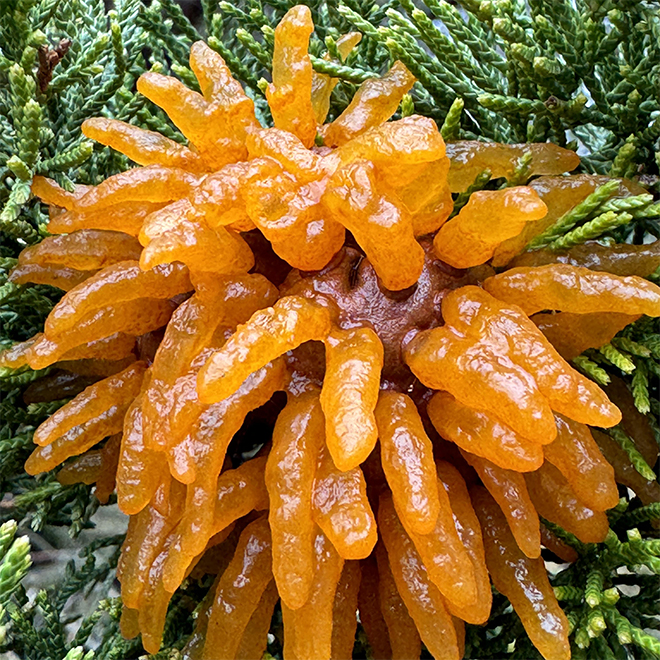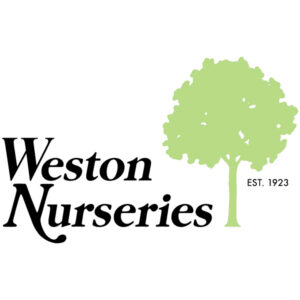The native fungal pathogen Gymnosporangium juniperi-virginianae causes cedar-apple rust.
Many rust fungi require two botanically unrelated hosts to complete their life cycle. For several Gymnosporangium species, including G. juniperi-virginianae, these include rosaceous trees and shrubs and Juniperus species. The primary rosaceous host is apple/crabapple (Malus), while eastern redcedar (J. virginiana) and Rocky Mountain juniper (J. scopulorum) are the primary alternate host (Sinclair and Lyon 2005). However, several other Juniperus species are also susceptible to infection, such as Chinese juniper (J. chinensis), creeping juniper (J. horizontalis), and common juniper (J. communis). The disease also occurs rarely on hawthorn (Crataegus).
The most frequently noted symptom of cedar-apple rust is the bright red-orange-yellow spots that develop on apple/crabapple leaves in mid-summer. However, the season’s first symptoms begin much earlier in the spring on Juniperus. Junipers and redcedars harboring the pathogen develop 0.25–2” diameter, rounded galls on infected needles and small twigs. In some cases, the galls can be much larger. During periods of wet and mild weather in the spring, typically from mid-April to mid-May in southern New England, the juniper galls secrete orange-brown gelatinous tendrils (known as telia). Non-infectious spores (teliospores) coat the tendrils and germinate in place, subsequently releasing infectious spores (basidiospores) (Sinclair and Lyon 2005). These infectious basidiospores drift on local air currents, mostly during the night and early morning, to infect the foliage of susceptible apple/crabapple. If they land on leaves that remains wet for periods of 4–6 hours, infection takes place. Several weeks after infection, yellow spots begin to form across the surface of the leaves. By mid-summer, the spots become orange to red or yellow with reddish-orange margins and develop a swollen mass with cream-colored tendrils on the underside of the leaf (known as aecia). Aecia release spores (aeciospores) that are wind-dispersed to nearby juniper and redcedar trees and shrubs in late summer to early autumn. In southern New England, this sporulation periods lasts from roughly mid-July to mid-September. Initially, infected juniper needles and twigs show no symptoms of infection. However, during the following spring and summer, small green to brown swellings (immature galls) are formed. The galls reach full size by the end of the growing season (approximately one year after infection) but do not mature and develop the gelatinous tendrils until the following spring (approximately 20–22 months after infection) (Sinclair and Lyon 2005).
In many landscape settings, cedar-apple rust causes little, if any, lasting damage to both junipers and apples/crabapples. At times, the disease can be serious on infected apples, resulting in premature leaf shedding and reduced fruit yield. If possible, avoid growing susceptible junipers in close proximity to crabapples and apples. While most basidiospores infect apple and crabapple trees within a few hundred yards of the juniper host, basidiospores are capable of traveling several miles. If the disease is a problem and avoidance or replacement is not an option, grow rust-resistant varieties of Malus. Apple cultivars with considerable resistance to cedar-apple rust include: Delicious (red), Empire, Keepsake, Liberty, McIntosh, Milton, Niagara, Paulared, Regent, Spartan, and Viking. Additionally, there are a number of resistant crabapples, such as: Adams, Candied Apple, Chestnut, Dolgo, Kelsey, Sargent, Snowdrift, and Thunderchild (New England Tree Fruit Management Guide 2020). Fungicides are not recommended for control of this disease because of the long periods of time when spores can infect both apple and crabapple (spring to early summer) and junipers (late summer to early autumn). Pruning of apples and crabapples to promote light and air flow, especially on interior branches, can help to reduce leaf wetness, a prerequisite for infection. Prune dormant galls from junipers during the fall, winter and early spring before the orange-colored spore tendrils are formed.
Citations: New England Tree Fruit Management Guide, 2020
Sinclair WA and Lyon HH. 2005. Diseases of Trees and Shrubs, 2nd edn. Cornell University Press, Ithaca, NY.
Source: Center for Agriculture, Food, and the Environment- UMass Extension Landscape, Nursery and Urban Forestry Program








